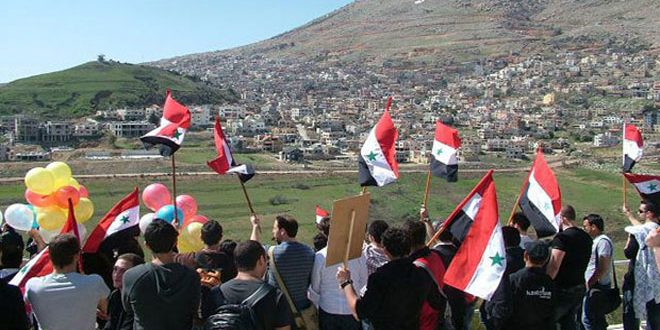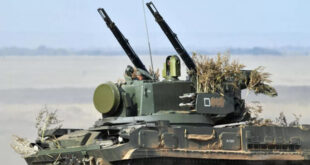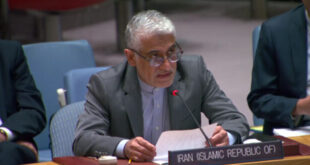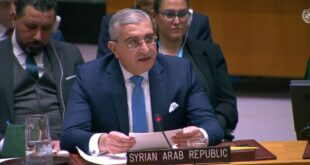Damascus, SANA- All written words throughout history in rejection of occupation and usurpation of lands, every inch of the Golan’s land and the sacrifices by the Syrian people to liberate it from the “Israeli” occupation affirm that it is the beating heart of Syria and it is impossible to Judaize or usurp it.
The Golan has a deep-rooted cultural history since the Palaeolithic (Old Stone Age) as it has been inhabited by the Canaanites, the Assyrians, the Amorites, the Arameans, the Chaldeans, the Nabataeans, the Romans, the Byzantines, and the Arabs .
The US President Donald Trump’s declaration on the occupied Syrian Golan will remain mere ink on paper and without any value, particularly as the UN resolutions ban the recognition of occupation’s sovereignty over the lands it usurps as a result of war.
Historian Mahmoud al-Sayyed at the Antiquities and Museums General Directorate says that the archeological finds affirm that the Golan is an inseparable part of the homeland Syria and that the archeological sites in the Golan are historically linked to the successive civilizations in Syria.
The archeological antiques unearthed in 170 archeological sites in the occupied Golan document the life of their residents since the Old Stone Age till the current rime, al-Sayyed said.
He affirmed that the Golan has been famous for the fertility of its land and for the apple and grape trees, in addition to the ranches.
Since the independence of Syria, the Golan has been the main source of vegetables and citrus at Damascus markets, and the Golan is a rich land which can be cultivated with all types of fruits, grains and bushes.
Quneitra had been the administrative and the commercial center of the Golan area before June 1967, and during the 1976 war, the Zionist entity occupied the Syrian Golan and in October Liberation War a part of the Golan was liberated and in 1974 Syria restored an area of 60 km from the Golan which includes Quneitra City and its surroundings and al-Rafid village.
In December 1981, the Israeli Knesset decided to annex the occupied part of the Golan to the occupation entity which entailed an international rejection of that ominous decision as it was rejected by the Security Council in its resolution no. 497 for the year 1981.
Although, the UN affirms that the Golan is an occupied Syrian land, the US President issued an ominous declaration on the occupied Syrian Golan as he recognized the sovereignty of the occupation entity over the Golan, and the UN issued a statement in which it announced that Trump’s proclamation doesn’t change the legal status of the Golan as a land under the Israeli occupation.
Al-Sayyed added that the Golan extends over an area of about 1860 square km as the area occupied by “Israel” is estimated at 1150 km.
The occupied Golan enjoys a wet mountain climate and it is considered as a part of above tropical area where temperatures are high and the annual averages are high or medium in a way that creates a climatic diversity ranging from cold and moderate to warm and it is an ideal environment for agriculture throughout the year.
The Golan also embraces natural, geographical and archaeological sites and a prominent position in the cultural heritage of the region, particularly the Christian heritage as it was visited by Jesus Christ who also stayed in it.
Historian al-Sayyed noted that the Golan is rich in water and it is considered as a source of water for one third of Tiberias Lake and to the north of Golan, there is a volcanic crater which constitutes Ram natural lake which is located between Majdal Shams village and Masada village.
Ram Lake has a capacity of 13 million cubic meters of water and it extends over an area of about 1 km and it is considered a unique lake in Syria and the Arab World as a whole.
One of the most important rivers of the Golan is Banias River, which is located at the western basin and it stems from the foot of Mount Hermon in the north of the Golan near the plain of al-Hula, and al-Yarmouk River to the south of the Golan.
The most important springs are located at the western basin, and the Zionist entity have worked on digging deep wells in all parts of the Golan and these wells consume the underground water and they affect the springs.
The location of the Golan has endowed it with a great importance as it has been the area through which convoys, armies and peoples have passed since the ancient times, and the unearthed archeological antiques in the Golan prove its continued junction with Damascus and Horan.
The Golan has been also a road knot as it links Syria with Lebanon and Palestine and it links Jordan with Egypt and the Arabian Peninsula since the Old Bronze Age.
The Golan is also a junction of the commercial roads network between the Mediterranean and the Arabian Peninsula and most of the ancient roads meet in it.
At the archeological site of Khasfin, old stone-paved roads were discovered including a road linking Khasfin with Jerusalem and another road linking Khasfin with Tiberias.
Al-Sayyed added that the Golan is also one of the unique archeological sites as it is rich in the archeological monuments which date back to per-historic eras and to the Old Bronze Age , the Iron Age, the Roman Age, the Byzantine age and the Islamic Age.
The historian added that all the archeological finds in Golan which are showcased at Katzrin Museum prove that the Golan is a Syrian land despite of that the Zionist entity made a precise and comprehensive survey for the lands in the occupied Golan, it hasn’t been able to provide any evidence on the presence of the ancient Hebrews in the Syrian Golan.
The Syrian historian affirmed that Trump’s proclamation on the Golan contradicts with the international resolutions and violates the resolutions of the Security Council and does not change the fact that the Golan is an occupied Syrian land and the international and UN duty is to restore it to its motherland Syria.
Ruaa al-Jazaeri
 Syrian Arab News Agency S A N A
Syrian Arab News Agency S A N A




